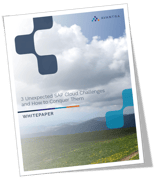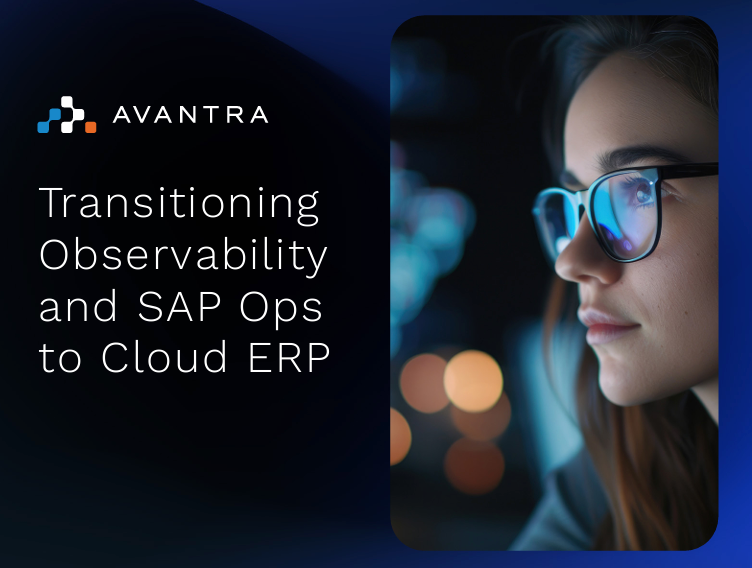5 min read
How CIOs can improve business results through SAP and cloud management
By: Tyler Constable on Apr 23, 2019 9:45:04 PM

By effectively and consistently managing SAP and the cloud CIOs can actively improve business process monitoring, predict resource consumption, improve SAP system security, and enable cloud scalability.
It’s no secret that organizations perform best when their CIO plays an active role in business strategy. Far from just taking care of the behind-the-scenes of companies’ IT infrastructure, it’s crucial that the CIOs of today’s businesses are consistently considering how IT can meaningfully shape their future. In fact, reports show that where CIOs are more involved in business strategy, IT performance is more effective -- especially managing IT infrastructure. And in this survey, 70 percent of respondents said that improving business processes was a “core expectation” of the CIO. So, it’s clear that the two should go hand-in-hand.
There’s no area where this alignment of IT performance with business results proves more relevant than in the management of SAP and the cloud. For many organizations, SAP systems are the backbone to their business. Yet with SAP not being the main line of business, many CIOs have a tendency to overlook the attention it needs.
However, by effectively and consistently managing SAP and the cloud, CIOs can actively improve business process monitoring, predict resource consumption, improve SAP system security, and enable cloud scalability. Here are the top reasons why CIOs should be paying close attention to SAP and cloud management.
Business process monitoring
Organizations can’t afford to leave delayed or bottlenecked business processes unidentified until weeks - or even hours or minutes - after they start to occur. Rather than face consequences such as loss of operational performance, delay in production, or excess expenditure when things goes wrong, companies need to nip these issues in the bud before they snowball.
Managing SAP on premise and in the cloud is key to avoiding failures that can result from suboptimal business processes. Instead of spending time manually monitoring servers and databases, with SAP, IT departments can monitor business processes from end to end, allowing for early detection of problems that could turn into a crisis.
For example, having real-time visibility and transparency of processes that connect suppliers, customers, and assets is crucial to mitigating delays that could put any of these stages of manufacturing and supply chain at risk. So, the closer an eye CIOs have on these processes, the more smoothly and efficiently they’ll run -- and managing SAP facilitates that.
Predictive resource consumption
Knowing how much a business can expect to spend in coming months, or indeed years, is a huge benefit that impacts other important budgeting decisions. By managing SAP and the cloud effectively, CIOs can see growth patterns that give them insights into how much disk or cloud space the company will need. By accounting for future resources based on past consumption, CIOs can prioritize and plan effectively for future resource consumption and ultimately save money.
SAP system security
Systems’ security - a segment of SAP that’s often overlooked - deserves much closer attention than it currently receives from many CIOs. And while either end of this security spectrum are crucial to take care of - cybersecurity and government regulation compliance - they typically get the majority of attention. It’s important to realize that there’s also a lot that goes on in-between these two poles that lacks careful management.
Just because the internals of your SAP systems aren’t exposed to general end users on the company network doesn’t mean they’re safe to ignore in terms of security. In fact, more than 40 percent of security breaches are caused by employee negligence. So, when monitoring SAP for security and compliance, removing any information gaps is essential, and not doing so could ultimately cost CIOs their jobs.
For example, companies need to be aware that they have information gaps during an upgrade, planned maintenance, or during migration - meaning that when some elements of the systems are down, others are not being monitored. And remember, non-compliance is much more costly than compliance, with the average expenditure being $14.8 million, compared to $5 million on compliance.
Cloud scalability
Public cloud adoption is now mainstream, with 73 percent of organizations having at least one application or a portion of their computing infrastructure in the cloud. So, it’s unsurprising that running SAP on the cloud has numerous benefits, including innovation, a dynamic landscape size, minimized infrastructure maintenance, and cost savings.
However, unless CIOs take specific steps to make sure SAP is able to scale according to the organization’s needs, the company can end up spending more than they need to on excess resources, and lose out on operational performance.
It’s important for IT teams to understand that moving to the cloud doesn’t automatically mean scalability for SAP, as the application wasn’t built to use a dynamically changing infrastructure. In order to scale cloud resources up or down, businesses need (otherwise lacking) visibility into SAP and the activities that are running inside it to make sure that nothing crucial is running during the shutdown procedures.
This means that in order to save on costs and benefit from a dynamic cloud environment, the organization needs to put in a lot of human work to manually shut down SAP systems during quieter times, and then spin up a new application server when it’s needed.
However, solutions exist that constantly monitor the system for decreased usage and then automatically scale SAP down with the cloud system, as well as allowing SAP to scale up and use new resources as it automatically identifies them. This gives teams peace of mind that the cloud doesn’t automatically shut down any crucial operations. It also ensures that the system automatically scales based on the performance and needs of their system, with no need for manual monitoring or scaling -- ultimately helping teams save on time and costs and drive business outcomes.
Bottom line
So, it’s clear that managing SAP on premise and in the cloud to improve business results is not a simple task for CIOs. But, keeping on top of everything going on inside SAP is more important than many IT departments realize. By using SAP to gain insights into business processes, predict future resource consumption, ensure SAP system security and enable cloud scalability, CIOs can fundamentally drive positive business outcomes.
Want to l earn more?
earn more?
Download this free white paper:
3 Unexpected SAP cloud challenges and how to conquer them
The article was originally published on SmartMSP
Photo by Vince Fleming on Unsplash
Related Posts
Digital Transformation: Navigating the Challenges of SAP on the Cloud
Cloud migration is supposed to improve your SAP system performance, but it could be an expensive...
Failure to Automate = Failure to Operate SAP in the Cloud
Much of SAP logic was written before cloud computing. So simply migrating on-premises SAP systems...
Smart Cloud Automation - SAP on Public Clouds
Enterprises and Managed Service Providers (MSPs) are finding that implementing and leveraging the...




